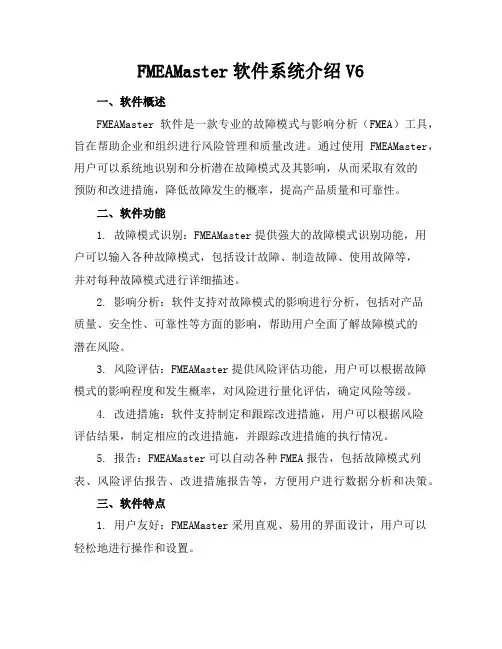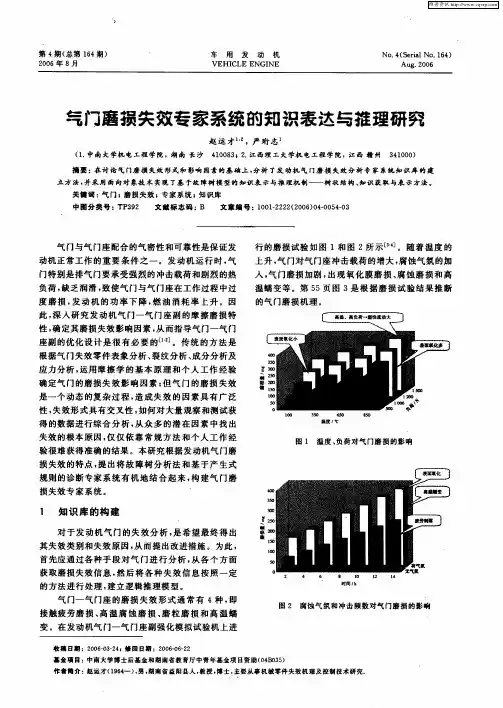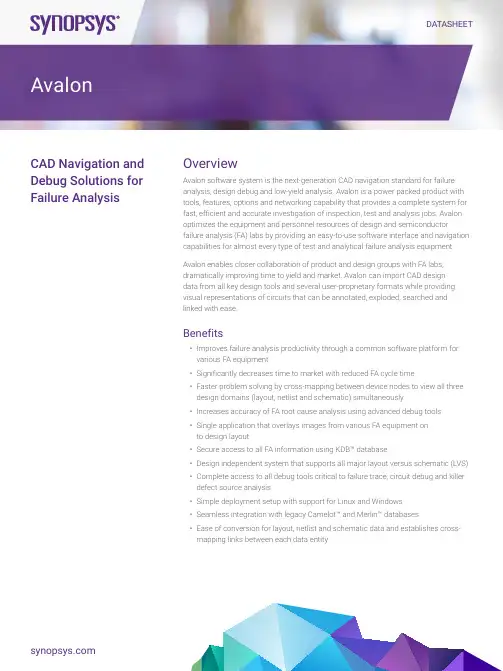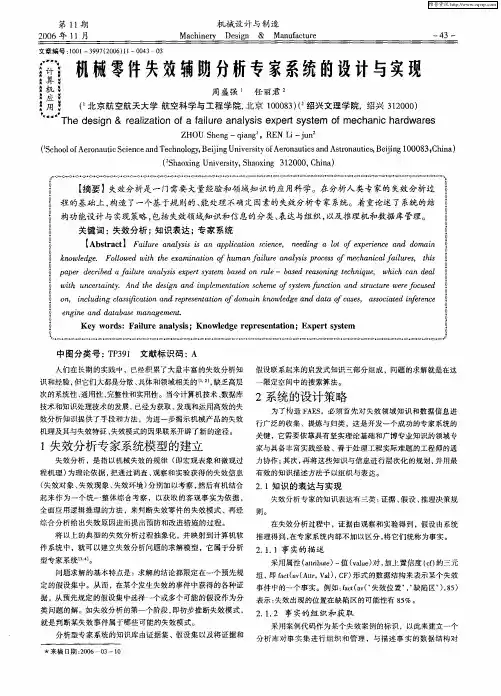失效分析专家系统
- 格式:pdf
- 大小:306.72 KB
- 文档页数:3


FMEAMaster软件系统介绍V6一、软件概述FMEAMaster软件是一款专业的故障模式与影响分析(FMEA)工具,旨在帮助企业和组织进行风险管理和质量改进。
通过使用FMEAMaster,用户可以系统地识别和分析潜在故障模式及其影响,从而采取有效的预防和改进措施,降低故障发生的概率,提高产品质量和可靠性。
二、软件功能1. 故障模式识别:FMEAMaster提供强大的故障模式识别功能,用户可以输入各种故障模式,包括设计故障、制造故障、使用故障等,并对每种故障模式进行详细描述。
2. 影响分析:软件支持对故障模式的影响进行分析,包括对产品质量、安全性、可靠性等方面的影响,帮助用户全面了解故障模式的潜在风险。
3. 风险评估:FMEAMaster提供风险评估功能,用户可以根据故障模式的影响程度和发生概率,对风险进行量化评估,确定风险等级。
4. 改进措施:软件支持制定和跟踪改进措施,用户可以根据风险评估结果,制定相应的改进措施,并跟踪改进措施的执行情况。
5. 报告:FMEAMaster可以自动各种FMEA报告,包括故障模式列表、风险评估报告、改进措施报告等,方便用户进行数据分析和决策。
三、软件特点1. 用户友好:FMEAMaster采用直观、易用的界面设计,用户可以轻松地进行操作和设置。
2. 可定制性:软件提供灵活的定制选项,用户可以根据自己的需求进行个性化设置,满足不同项目的特定要求。
3. 数据共享:FMEAMaster支持数据共享功能,用户可以将FMEA 数据导出为Excel、Word等格式,方便与其他团队成员进行交流和协作。
4. 多语言支持:软件支持多种语言,包括中文、英文、日语等,满足不同国家和地区的用户需求。
四、软件应用领域FMEAMaster软件广泛应用于各个行业和领域,包括汽车制造、航空航天、电子电器、医疗设备、机械设备等。
无论是新产品开发、生产工艺改进还是质量管理体系建设,FMEAMaster都可以提供有效的支持和帮助。


专家系统故障诊断方法
专家系统是一种基于人工智能技术的计算机系统,其设计目的是模拟专家的知识和经验,用于解决复杂的问题。
在实际应用中,专家系统常常用于故障诊断和问题解决。
故障诊断是专家系统的重要应用之一。
在现代社会中,许多系统和设备都非常复杂,一旦出现故障,往往需要专业的知识和经验来诊断和解决。
专家系统通过将专家的知识和经验编码成规则和推理机制,可以快速准确地诊断和解决各种故障。
专家系统故障诊断方法可以分为以下几个步骤:
1. 知识获取:首先需要从专家那里获取故障诊断所需的知识和经验。
这可以通过面谈、观察和文献研究等方式进行。
2. 知识表示与编码:获取到的知识和经验需要转化为计算机可以处理的形式,通常是规则和推理机制。
规则是一种以“如果-那么”形式表示的知识,推理机制则是用于根据规则进行推理和推断的方法。
3. 诊断推理:在诊断推理阶段,根据用户提供的故障现象和系统信息,专家系统将使用已编码的知识和推理机制进行推理和推断,以确定可能的故障原因。
这通常涉及到多个规则的匹配和推理链的构建。
4. 故障排除:在确定可能的故障原因后,专家系统还可以提供相应的故障排除建议。
这些建议通常是基于专家知识和经验的,可以帮助用户解决故障。
5. 知识更新与维护:随着时间的推移,系统的故障诊断知识和经验可能会发生变化。
因此,定期对专家系统的知识进行更新和维护是很重要的,以保证其准确性和有效性。
综上所述,专家系统故障诊断方法是一种基于专家知识和经验的计算机辅助诊断方法。
通过将专家的知识和经验编码成规则和推理机制,专家系统可以快速准确地诊断和解决各种故障。

DATASHEET Overview Avalon software system is the next-generation CAD navigation standard for failure analysis, design debug and low-yield analysis. Avalon is a power packed product with tools, features, options and networking capability that provides a complete system for fast, efficient and accurate investigation of inspection, test and analysis jobs. Avalon optimizes the equipment and personnel resources of design and semiconductor failure analysis (FA) labs by providing an easy-to-use software interface and navigation capabilities for almost every type of test and analytical failure analysis equipment.Avalon enables closer collaboration of product and design groups with FA labs, dramatically improving time to yield and market. Avalon can import CAD design data from all key design tools and several user-proprietary formats while providing visual representations of circuits that can be annotated, exploded, searched and linked with ease.Benefits • Improves failure analysis productivity through a common software platform for various FA equipment • Significantly decreases time to market with reduced FA cycle time • Faster problem solving by cross-mapping between device nodes to view all three design domains (layout, netlist and schematic) simultaneously • Increases accuracy of FA root cause analysis using advanced debug tools • Single application that overlays images from various FA equipment on to design layout • Secure access to all FA information using KDB™ database • Design independent system that supports all major layout versus schematic (LVS)• Complete access to all debug tools critical to failure trace, circuit debug and killer defect source analysis • Simple deployment setup with support for Linux and Windows • Seamless integration with legacy Camelot™ and Merlin™ databases • Ease of conversion for layout, netlist and schematic data and establishes cross-mapping links between each data entityCAD Navigation andDebug Solutions forFailure AnalysisAvalonFigure 1: Avalon CAD-navigation system integrating layout, signal tracing and 3D viewSupporting all CAD Design DataSynopsys is committed to being the leading provider of software solutions that links all CAD design data. Avalon is a comprehensive package that reads all EDA tools and design data from verification systems and several user-proprietary formats. The KDB™database is designed to interface with all key design formats.Today, there are more EDA developers and more verification package choices; Synopsys is the only company thatsupports all of them.• LVS Conversions: Cadence (Assura, DIVA), Mentor Graphics (CheckMate, Calibre), Synopsys (Hercules, ICV)• Netlist Conversion: SPICE, EDIF, OpenAccess• Layout Conversion: GDSII, OASIS®The highest priorities for Avalon users are faster data accessibility, support diverse failure analysis equipment and availability of debug tools. Avalon provides the optimal solution for both small and continually-expanding FA labs and design debug teams. The Avalon database is design independent and offers a superior level of data consistency and security. The unique design of the internal database schema guarantees compatibility with decades-old databases. This is an indispensable feature for all failure analysis, QAand manufacturing organizations especially in the automotive industry.Figure 2: Avalon SchemView and NetView provide an easy way to navigate inside circuit schematicsProviding Critical Analysis FunctionsIn addition to its CAD navigation and database capabilities, Avalon’s analysis features have become indispensable to the FA lab. Different viewing options are critical in tracking potential failures and determining the source and origin of killer defects. Avalon includes special schematic capabilities and layout features that are invaluable to FA engineers as they debug chips manufactured using new processes.Avalon View Only Client consists of maskview, netview, schemview, i-schemview, K-EDIT, defect wafermap and 3D-SAA. The list below details some of the most commonly used applications.Defect Wafer Map integrates defect inspection data with the device CAD design using the defect coordinates to navigate an equipment stage and pinpoint the defect for closer inspection and characterization. Avalon sorts defects by size, location or class, as well as layout location and allows the user to define custom wafer maps. Additionally, users can classify defects, attach images and write updated information to the defect files.Figure 3: Defect Wafer Map pinpoints defects for closer inspectionSchemView provides tracking of potential failures through visualization of the chip logic. Cross-mapping of nets and instances to the device layout and netlist, SchemView helps determine the source and origin of chip failures. SchemView helps determine the source and origin of chip failures. The entire design is displayed in cell hierarchy format, allowing push-down to a transistor level.Figure 4: K-Edit allows collaboration between design, fab and labI-Schem (Interactive Schematic) creates a schematic from a netlist in a net-oriented format allowing forward and backward tracking to locate a fault. Features like Add Driver or Add Input Cone allow for quick analysis and verification of diagnostic resultsin scan chains.Figure 5: I-Schem creates a schematic from a netlistK-Bitmap allows equipment CAD navigation when analyzing memory chips by identifying the physical location of failingmemory cells. It eliminates tedious screen counting by converting the logical addresses, or row and column coordinates, to thephysical location.Figure 6: K-Bitmap identifies the physical location of bit addresses in memory devices3D Small-Area Analysis provides a three-dimensional cross- section capability to FA engineers, enabling faster localization of circuit failures to accelerate IC manufacturing yield improvement.Figure 7: 3D Small-Area Analysis enables faster localization of circuit failuresHot-Spot Analyzer allows user to draw regions on the layout that correspond to hot-spot regions (emission spots) to detect the crucial nets. It finds the nets in each hot-spot region and plots a pareto graph of nets crossing one or more hotspots which helps to easily locate the killer net.Figure 8: Hot-Spot Analyzer displays number of nets in a hot spotUser-Defined Online Search (UDOS) allows users to search a small area of a die for unique polygon features, repeated features or lack of features. Applications include, but are not limited to, FIB-able regions, repeaters, pattern fidelity and lithographic applications.Figure 9: User-Defined Online Search (UDOS) finds easy-to-access tracesPassive Voltage Contrast Checker (PVC) quickly and accurately validates the integrity of a circuit’s conductivity and provides detailed information for identifying suspect faults at via or metal tracesFigure 10: Passive Voltage Contrast (PVC) Checker identifies suspect vias or metal tracesElectronic Virtual Layer marks objects to represent net connectivity during a FIB deposit or cut using KEdit. The online trace will simulate the new connectivity to the virtual layer. PVC checker could be used on this virtual layer to simulate the crack or short.Check Adjacent Nets allows logical analysis of nets. This command line tool finds the adjacent nets which are within user-specified threshold distance to find shorts.Export Partial Layout enables the customer to share partial layout data with service labs without compromising the IP of the product.Image Mapper automates the image alignment process in Avalon Maskview and saves a lot of time and effort spent inmanual alignment.Advanced 3D Viewer displays real time 3D view of the selected layout area. It shows each process step in the 3D view for which it uses the process data along with design data. It zooms into smaller details and helps to minimize unintended consequences during FIB cuts due to underneath high density structure.Avalon SolutionAvalon brings all the advantages of enterprise-wide computing for FA of the chip. Avalon is an open architecture system that connects users over local and wide area networks for seamless integration and database sharing. Instrument integration throughout the fab and other locations throughout the enterprise enables viewing, modifying, characterizing and testing the same wafer location with different instruments, or the same location on wafers at different facilities using the same chip design.Figure 11: Avalon’s open architecture integrates with Synopsys’ Yield ExplorerIC DesignToolsFigure 12: Avalon server solutionComprehensive Library of FA Tool DriversAvalon provides navigation with almost every equipment used in the FA lab. With a continued commitment to support drivers for all types of test and analysis equipment, Synopsys will continue to develop driver interfaces for new tools as they are introduced to the market, as well as the next generation of existing tools.Equipment Supported by Avalon• Analytical Probe Stations• Atomic Force Microscopes• E-Beam Probers• IR Imaging• Mechanical Stage Controllers• Emission Microscopes• Microanalysis Systems• FIB Workstation• Laser Voltage Probe• LSM• EDA LVS• Microchemical Lasers• OBIC Instruments• Optical Review• SEM Tools• Photon Emission Microscopes• Laser Scan Microscopes©2018 Synopsys, Inc. All rights reserved. Synopsys is a trademark of Synopsys, Inc. in the United States and other countries. A list of Synopsys trademarks isavailable at /copyright.html . All other names mentioned herein are trademarks or registered trademarks of their respective owners.。

基于故障诊断专家系统的研究
一、引言
随着现代技术的发展,故障诊断专家系统已经成为一种很受欢迎的现代技术,用于故障诊断和相关专家系统的研究也已经成为一个活跃的研究领域。
本文将对故障诊断专家系统的研究做出简要的详细描述,并介绍其应用领域。
二、故障诊断专家系统基础
故障诊断专家系统(FDE)是一种系统,它使用人工智能技术来帮助技术人员和客户诊断和解决设备和系统故障。
它结合了以下技术:规则和技术,模式识别,深度学习,机器学习,建模和模拟,图灵机技术,自然语言处理,技术语言,以及人机交互等技术。
它们的主要作用是模拟相关专家的技能,并根据实时输入信息和历史数据,对复杂的故障情况进行识别、推断、诊断和解决。
三、故障诊断专家系统的应用
(1)电力系统的控制和管理。
发电厂和电网的控制和管理是由故障诊断专家系统来完成的,它们将仿真模型与实时监测系统结合起来,建立电力系统的模型,同时还可以发现电力系统中出现的异常情况,进行定位和诊断,以及提出解决方案。
(2)计算机网络的安全保护和管理。
由于网络受到许多安全隐患的威胁,因此。


LIMS介绍及在各行业实验室的应用1.LIMS介绍实验室信息管理系统(英文缩写为LIMS),就是指通过计算机对实验室的各种信息进行管理的计算机软、硬件系统。
对一个实验室来说,无论规模的大小,每时每刻都会产生大量的信息,这些信息主要是一些测量、分析的数据,还有许多维持实验室运行的管理型数据,这些数据是如此的复杂,如此的海量,使得每一个实验室为维护这些数据而浪费了大量的人力和物力,结果效率还十分的低下,经常出错,更谈不上数据的快速科学分析。
另外大规模的实验室在管理上也同样存在着头绪繁多,管理混乱的现象。
所有的这一切都是因为缺乏一种有效的、快捷的、使用方便的管理工具所致。
解决这一问题的唯一办法,就是引入LIMS——实验室信息管理系统,因此,利用计算机网络技术、数据存储技术、快速数据处理技术来对实验室进行全方位管理的计算机软、硬件系统。
通过LIMS,实验室可以达到自动化运行、信息化管理和无纸化办公的目的,对实验室提高工作效率、降低运行成本起到至关重要的作用。
LIMS作为信息管理系统,它有着与ERP、MIS之类管理软件的共性,但是也有自己鲜明的个性。
首先,作为实验室的管理软件,它是有标准可以遵循的。
它的系统方案设计必须严格遵循由国家质量技术监督局颁布的国家标准《检测和校准实验室能力的通用要求》,该标准等同于ISO/IEC17025:1999,而ERP、MIS之类软件没有相应的标准可以执行,这就使得不同用户的ERP之间可以存在巨大的差异,而LIMS则没有,这一点非常有利于产品的推广。
其次,不同行业的LIMS尽管由于行业的原因会有所差别,但归根结底,实验室大量进行的是测试或校准行为,业务性质鲜明,产品非常易于标准化。
而实验室无论从设备到业务性质直至从业人员,都处在一个较高的素质水平上,它们对LIMS的接受能力是很强的。
再有,LIMS不仅仅能为实验室提供一个管理的平台。
还能为提升整个实验室的运行效率、学术水平等等提供更多帮助。

汽车故障诊断与维修专家系统设计随着汽车普及率的日益增长,汽车故障诊断与维修变得非常重要。
为了提高汽车维修的效率和准确性,设计一个汽车故障诊断与维修专家系统是必不可少的。
本文将介绍如何设计一个有效的汽车故障诊断与维修专家系统,以帮助技术人员更好地解决汽车故障。
首先,汽车故障诊断与维修专家系统应该包括一个完善的故障诊断模块。
这个模块可以根据车辆主人提供的故障描述和车辆检测数据,自动分析问题,并给出最有可能的故障原因。
为了实现这个功能,可以使用机器学习的方法,通过大量的历史故障数据进行训练,建立一个故障诊断模型。
这样,当新的故障发生时,系统就可以根据之前的训练结果进行快速诊断。
其次,汽车故障诊断与维修专家系统还需要一个维修建议模块。
这个模块可以根据故障诊断结果,向技术人员提供相应的维修建议。
例如,如果诊断结果显示是发动机故障,系统可以提供更具体的维修指导,如更换特定的零部件、调整相关参数等。
为了提供准确的维修建议,一个可行的方法是建立一个知识库,其中包含了各种不同故障对应的解决方案。
技术人员可以通过查询这个知识库,获取相关故障的维修建议。
此外,汽车故障诊断与维修专家系统还应该具备实时更新的能力。
随着汽车技术的不断发展,新的车型和故障类型不断出现。
为了保证系统的准确性和可靠性,需要定期更新系统的数据库和模型。
这样,系统就能及时了解到新的故障情况,并进行相应的诊断和维修建议。
另外,为了提供更好的用户体验,汽车故障诊断与维修专家系统可以考虑添加一些额外的功能。
例如,可以设计一个故障排查流程导航模块,帮助技术人员按照一定的流程来进行故障排查,避免漏检或者冗余检查。
同时,系统还可以提供实时在线咨询的功能,让技术人员可以随时向专家请教,以解决一些复杂的故障问题。
最后,为了保证汽车故障诊断与维修专家系统的可用性和稳定性,需要进行良好的系统测试和质量控制。
在设计系统的时候,可以考虑使用敏捷开发的方法,通过迭代式开发和测试,逐步完善系统的功能和性能。


专家系统在故障诊断中的应用
专家系统在故障诊断中的应用是为了替代计算机系统,完成对设备及其工作环境的诊断、检测、测量和修复等任务。
专家系统在故障诊断中的应用有以下特点:
1、能够提供准确的故障诊断和维修方案给外界,利用专家系统技术进行快速准确的故障诊断。
2、不仅能在规定时间内完成故障诊断,而且故障现象的表达通常能够较准确的引导系统构建者构造合理的假设、思维,进而提高故障诊断的准确率。
3、专家系统能够在系统辨识的过程中智能调整参数,从而达到自动化调试的目的,具有规划较强的优势。
4、专家系统在预防故障方面,能够将专家知识和经验总结系统,形成完整的故障预测预防系统,降低故障发生率,提高设备利用率。
5、在复杂技术领域中,专家系统可以帮助技术人员及时和准确地检测、分类、诊断故障,并更加深入地了解设备的工作原理和行为规律。
第六章故障诊断专家系统专家系统概述专家系统(Expert system简称ES)是人工智能的一个分支领域,在自然科学、社会科学、工程技术的各个领域得到了广泛的应用,是人工智能领域中最具有吸引力、最成功的研究领域。
专家系统的发展可以分为孕育(1965年以前)、产生(1965—1971)、成熟(1972—1977)和发展(1978—)四个阶段[25]。
在70年代ES系统的成熟期,ES的概念与观点逐渐大众化,先后出现了一批较成熟的ES系统,主要是在医学领域,代表性的有MYCIN、CASNET、PROSPECTOR等ES 系统。
这一时期的ES系统与第一代系统相比具有:多数使用自然语言对话,多数系统具有解释功能,采用了似然推理技术。
进入80年代后,专家系统的应用范围更加广泛,已扩展到军事、空间技术、建筑设计和设备诊断等方面。
在设备的故障诊断领域中,近几年我国也开发了一些专家系统,主要是针对汽轮发电机组开发的故障诊断专家系统。
水电机组的结构与运行原理同汽轮发电机组相似,但却有不同之处,因此水电机组故障诊断的研究即具有一定的理论基础,又具有很大的必要性。
专家系统发展到现在,已经得到许多领域专家的认可,但是对于专家系统的定义到目前为止还没有一个统一的说法。
一种意见认为:专家系统是利用具有相当量的公认、权威的知识来解决特定领域中的实际问题的计算机程序系统,可以根据人为提供的数据、事实和信息,结合系统中存储的专家经验或知识,运用一定的推理机制进行推理判断,最后给出一定的结论和用户解释以供用户决策之用。
持有另一种意见的人则认为:专家系统是一个具有知识库和具体计算机的系统,其知识库中的知识来源于某领域专家的技能和经验;可以对某一任务提出建议或给出合理的决策;能判断自己的推理路线并以简明的形式显示出来;常采用基于规则的程序设计。
第三种意见认为:专家系统是一个使用知识和推理的智能计算机程序,它的目的是解决人类专家很难解决的一些问题;专家系统中的知识由事实和启发式信息构成,其事实构成了共享且为专家认可的知识信息体;专家系统的启发式信息则是一些独特的推理规则,如似然推理规则、优化猜测规则等。
失效分析的新方法—专家系统
王成志
【期刊名称】《机械工程材料》
【年(卷),期】1992(016)005
【总页数】4页(P42-45)
【作者】王成志
【作者单位】无
【正文语种】中文
【中图分类】TH132.41
【相关文献】
1.热力设备主要部件失效分析专家系统在爆管分析中的应用-国电兰州热电有限责任公司2号锅炉高温段过热器爆管情况分析 [J], 杨景建;张昕;苗兴;赵明忠;袁芳;李玉鹏;孟艳茹;岳月
2.航空机械装备失效分析技术在专家系统中的应用研究 [J], 沈朝萍;尚金秋;胡超;谢中敏;于鹏澎
3.航空机械装备失效分析专家系统应用研究 [J], 景武
4.汽车零部件失效分析专家系统的研究 [J], 宋文斌; 张玲玉
5.航空机械装备失效分析技术在专家系统中的应用研究 [J], 沈朝萍; 尚金秋; 胡超; 谢中敏; 于鹏澎
因版权原因,仅展示原文概要,查看原文内容请购买。